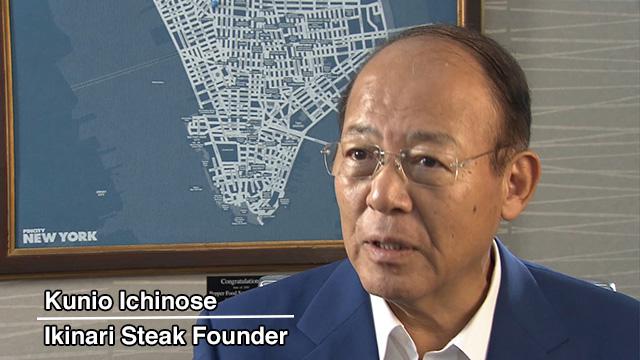I was only 20 days or so into my assignment to New York then, but I knew of the steakhouse from the film "Steak (R)evolution" that I watched 3 years before and I had my mind set on going there if I ever went to New York. New York's popular steakhouses are opening branches one after another in Tokyo these days. I had even been to one —Wolfgang's Steakhouse. I was eager to cover the story.
Founded in 1887, Peter Luger is a traditional American steakhouse. It's known as one of the two major classic steakhouses in NYC along with Keens Steakhouse. Wolfgang's and Benjamin, which have already penetrated Japan, were founded by former employees at Peter Luger. In other words, Peter Luger is the original "granddaddy" steakhouse. Dry aged beef, which it is known for, is popular in Japan as proven by the success of Wolfgang's and other steakhouses serving it. I wasted no time contacting Peter Luger's first branch in Brooklyn for an interview.

Greeting me at the restaurant was vice president Daniel Turtel, aged only 27.
The Peter Luger Steakhouse has been under family management since 1950, when the current owner purchased the restaurant that had dilapidated following the death of the original owner.
The restaurant is usually fully booked until more than a month ahead. Reservations can only be made by phone. And no credit cards are accepted. It must take a lot of courage for unfamiliar customers to admit to the waiter that they have no cash and need to look for an ATM.
"The selection of the meat is a family responsibility," Dan explained. He showed me to an underground storage area where no cameras were allowed. He smiled and said information such as the humidity, temperature, and length of the aging process is a business secret. The rich aroma that filled the room will surely remain with me for some time to come.

Dan says Peter Luger serves very rare beef that is cut out from the top 2 percent of the prime beef selected by the US Department of Agriculture. The interview with Dan proved quite educational. The popular T-bone steak that I saw in the kitchen was in fact a higher grade beef called the porterhouse.
USDA standards state that it consists of a filet that's at least 1.25 inches thick, with the thickness being measured from the bone to the widest point on the filet.
Case in point, the beef looked amazingly thick before it was cooked. Out of the oven, it was crispy with distinctive char on the outside, and juicy on the inside. My mouth is watering just recalling how tender it was.

But I was concerned about the portion sizes when it came to the Japanese market. The menu item "Steak for Two" consists of a porterhouse that's 40 ounces, or more than 1.1 kilograms, including the bone. I had an opportunity the other day to go to another well-known steakhouse. After a bowl of chunky soup, some bread and salad, and wine, I was fairly full, and honestly not sure I would be able to finish a main course.
I asked Dan, "The portions may be too large for the average Japanese. Are you planning to change them?" But he shrugged and replied, "No plans. We're not going to change anything. The meat will speak for itself."
Come to think of it, dining is not just about the meal, but about the atmosphere and good conversation. The food matters, but as long as it's tasty, it's good enough. Offering customers a dining experience similar to one they could get at their Brooklyn restaurant is what the owners trust will bring them success in Japan.

Meanwhile, a Japanese steak-restaurant chain is poised to join the highly competitive New York market. Ikinari Steak is enjoying rapid growth across Japan with its unique style.
The chain has 2 distinctive features. One is no chairs — customers eat while standing. The other is a gram-based ordering system. The cook cuts and grills the meat according to the customer's order on the spot. Ikinari Steak opened its first branch in Manhattan in February last year.

The branch initially gathered attention for its stand-up eating style, in which customers can grab quick meals. But once it realized US diners prefer to sit, it quickly installed chairs. It has also been fast to respond to the local dining style, in which meals are meant to be an enjoyable pastime, and has put ice cream and sake on the menu. Confident of its success, Ikinari Steak is planning to have 11 branches up and running in New York by the end of this year.

Ikinari Steak founder Kunio Ichinose argues there is a need for quick meals, even at steakhouses. "Many people are busy, New Yorkers and Tokyoites alike. Everybody is in a rush in developed countries. That's why I have no doubt such needs exist."
He boldly challenges the traditional American steak culture. Ikinari Steak uses Angus beef, the same as Peter Luger. It plans to offer Wagyu beef from cattle carrying both Angus and Japanese-bred genes.
Ichinose says, "Steak is much healthier than pizza and easier on the stomach. So it's good not just for dinner, but also for lunch. It's affordable enough to be consumed many times a week."

At Peter Luger, many of the customers I spotted at lunchtime were Asian — Japanese, Chinese, South Korean, Filipino, and Thai. One of the reasons the owners are opening a branch in Japan must be that doing so will help attract more Asians.
I checked the menu of Wolfgang's, one of the first brand name New York steakhouses that came to Japan and is expanding there. The only new item was white rice. I don't know if Peter Luger will offer white rice in Japan. All I know is that the steakhouse will bring with it an authentic experience and taste. Thinking about such things brings my mind back to the delicious sizzling steak I had, straight from the oven.
Surprisingly, despite its reputation, Peter Luger wasn't chosen as the most tasty steakhouse in the film "Steak (R)evolution." The honor went to an unexpected contestant. Throughout my coverage of the various steak restaurants, I was reminded of how quickly people's tastes for beef are diversifying. But I still like both American and Japanese steak.

